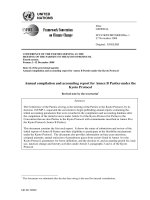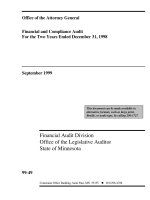IMPLEMENTING FINANCIAL AND ACCOUNTING SYSTEMS FOR GOVERNMENT
Bạn đang xem bản rút gọn của tài liệu. Xem và tải ngay bản đầy đủ của tài liệu tại đây (120.15 KB, 10 trang )
IMPLEMENTING FINANCIAL AND
ACCOUNTING SYSTEMS
FOR GOVERNMENT
CHRISTIAN T. SOTTIE
THE CONTROLLER AND ACCOUNTANT-GENERAL
GHANA
INTRODUCTION
• Today, strong financial management in
the public sector is not a luxury but a
necessity.
• We are in an era of increased demand
for accountability and transparency
• the "stakeholders" of the public sector
are demanding more effective and
efficient use of public resources
introduction
• Accountability – the ability of public officials (politicians and
technocrats)
– to answer for their actions and inactions and
– to show evidence that public funds were utilised for public Interest
• Transparency- ready access to reliable, comprehensive,
timely, understandable, and internationally comparable
information on government activities
• Predictability – procedures laid down by laws, regulations and
administrative instructions that are:
– clear and known in advance (documented),
– uniformly and effectively enforced.
• Participation decentralization and allowing participation in
decision making all levels of govt through representation, voting etc
Definition
•
•
•
•
•
Integrated Financial mgt System (IFMS) aims at improving accountability
by enhancing transparency and oversight in govt operations.
IFMS applies high technology to enhance financial mgt and reduce
mismanagement and corruption.
It is widely acknowledged that fully functioning IFMS contributes to
improved governance, by providing real-time financial information that
financial and other managers can utilize to effectively administer
programs, develop budgets and manage resources.
During the past decade, IFMS has been implemented in Africa with
varying degrees of success.
Where IFMS has been introduced successfully, it has increased public
sector legitimacy, produced timely and efficient accounting of public
resources, increased government accountability and transparency and
made it possible to audit public accounts and strengthen internal control
in government units
DEFINITION
Public Financial Management System (PFMS) is designed to
support all financial operations,
collect accurate, timely, complete, reliable and consistent
information on all public financial events,
provide adequate management reporting,
support government-wide and agency policy decisions,
produce auditable financial statements
INTEGRATED PUBLIC FINANCIAL MANAGEMENT
Core Treasury System includes the following components:
Budget Execution and Monitoring
Accounting (general ledger, management of payments and receipts)
Cash Management
Financial Reporting
Purchasing / Commitment
Asset / Inventory Management
Operational support for Spending Units
Other Public Financial Management System components:
Macro Economic Forecasting
Budget Preparation and Approval
Debt and Aid Management
HR Management /Payroll Calculations
Support for Financial Control and Auditing
Web publishing
Financial Management Information System
The combination of above components is referred to as integrated PFMS
6
Cycle for Public Fin Mgt
Policy Formulation
and Review
1
Budget
Preparation
Budget Execution
2
9
8
Audit and
Evaluation
Budget
Authorizations
3
Implementation
Commitment of
Funds
Budget Review
& Accounting
4
Purchasing
7
Debt and Aid
Mgt
Payments and
Receipts Mgt
6
Cash Mgt
5
Asset /
Inventory Mgt
Payroll/
HR Mgt
7
implementation of information
systems
Put up a system implementation team (user driven project)
Secure network infrastructure (countrywide if necessary)
Develop application software based on user requirement
Choose servers , data storage and backup units depending on software
System and network management tools
Technical maintenance and support systems
System safety / security and business sustainability/continuity solutions
Ensure user involvement in system design, configuration, testing and accepatance
Important points to note
Development of the core treasury system is an important milestone for the implementation
of a countrywide Public Financial Management System (PFMS), which enables integration
and exchange of information available in various systems (e.g. IRS, CEPS, Central Bank)
developed by different agencies.
The Financial Management Information System (FMIS), as the main decision support and
monitoring system for public finance, is based on centrally available information gathered
from all important components of the PFMS.
Development time for a fully functional treasury system in some transition economies and
developing countries varies between 3 to 5 years. Large scale implementations of the
treasury systems may take even longer. Eg Ghana started since 1996
Total cost of ownership of treasury system implementation depends on a number of factors,
such as institutional capacity, scope, desired functionality, number of users and
implementation method.
Lessons learnt
Development of modern integrated PFMS according to the best practices is a complex task, which should
be designed as a separate project.
Implementation of such wide spread changes would require:
Government commitment and management support at the highest levels to ensure that the change
process is completed smoothly
Inter-agency coordination and user involvement in system design
Building institutional capacity and technical skills starting from the preparation phase
Development of project management and technical support units within the Treasury for
implementation and sustainability of new systems
Donors support usually turns to dictate the passé beyond the capability of the user or set standards
that are not achievable
Dream big but start small. The “big bang “ approach may take forever to complete. Eg Ghana started
with 76 sites and 10 years later, the pilot sites were reduced to 8 sites
Incentive schemes should accompany the implementation since such project demand more efforts
and commitment than the regular job requirement of the public servant.









